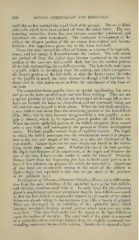Page 550 - My FlipBook
P. 550
560 DENTAL EMBRYOLOGY AND HISTOLOGY.
until the sac has reached the typal limit of its growth. The sac is filled
with cells which have been pushed off from the infant layer. The sur-
rounding connective tissue has now become somewhat condensed, and
constitutes the outer root-sheath. The continued development of the
cells at the deepest portion of the sac causes it to expand and become
bulbous ; this appearance gives rise to the term hair-bulb.
From this time onward the effort of Nature, as expressed in ingrowth,
ceases, and her energy is directed toward the surface. The cells which
are pushed off from the infant layer become condensed in the central
portion of the sac—not into a solid shaft, but into the cortical portion
of the hair surrounding the medullary cavity. The hair-bulb rests upon
a papilla, y\'\\ich is developed from the corium, and which invaginates
the deepest portion of the hair-bulb, so that the latter covers the sides
of the papilla in much the same manner as though a bell had been let
down over it ; this union serves to form the attachment of the base of
the hair.
The connective-tissue papillse have no special signification, but come
and go as the hairs are destroyed and new hairs develop. They are not
a special product of foetal life, but are developed all through life as new^
hairs are formed, for hairs are short-lived, and are constantly being cast
off', and new ones formed in their places. "NMien the hair-bulb atrophies,
a new bulb is sent down from the remaining portion of the hair-follicle
(Fig. 306) ; this in turn becomes invaginated by a new papilla ; a new
liair is formed, which by its upward growth pushes the old hair out.
Wiien the entire epithelial portion of the follicle atrophies, there cannot
arise a new bulb, and consequently the process of future development
ceases. The hair papillae contain loops of capillary vessels. The depth
to which the follicle penetrates into the subcutaneous tissue is in propor-
tion to the size and length of the hair, as is also the thickness of the
root-sheath. Larger hairs are set more deeply and firmly in the under-
Iving tissue than smaller ones. Whether the size of the hair governs
the depth and firmness of its attachment, or the depth and firmness the
size of the hair, I leave to the reader to settle for himself Probably
Nature knew from the beginning just how to build each part so as to
have it biest subserve the purpose for which she intended it. Questions
of this kind are continually arising in the mind of the student in
Embrvology, and especially is this true in our study of the products
of the epiblastic layer.
Dci-rlojtnicnt of Glands— Sebaceous Glands.—These are a differentia-
tion from the same infolding of the epithelial layer as the hair-follicle,
and develop sinndtaneously with it. In early foetal life the sebaceous
oland is much larger and more prominent than the hair-follicle—so much
so that the hair-fi)llicle is a])])arently situated in the mouth of the gland.
Sflmceous glands belong to tlie racemous type (like a buncli of grapes).
TJK'V are developed l)y an infolding of the epithelial layer, which
becomes involuted, forming several ])ockets which open into one com-
mon duct. This duct finds outlet into the sheath of the hair-follicle or
upon the surface of the skin. The outer wall of the gland is composed
of a connective-tissue envelope formed from the slightly condensed sur-
rounding connective tissue of the corium. Inside this is situated a layer


